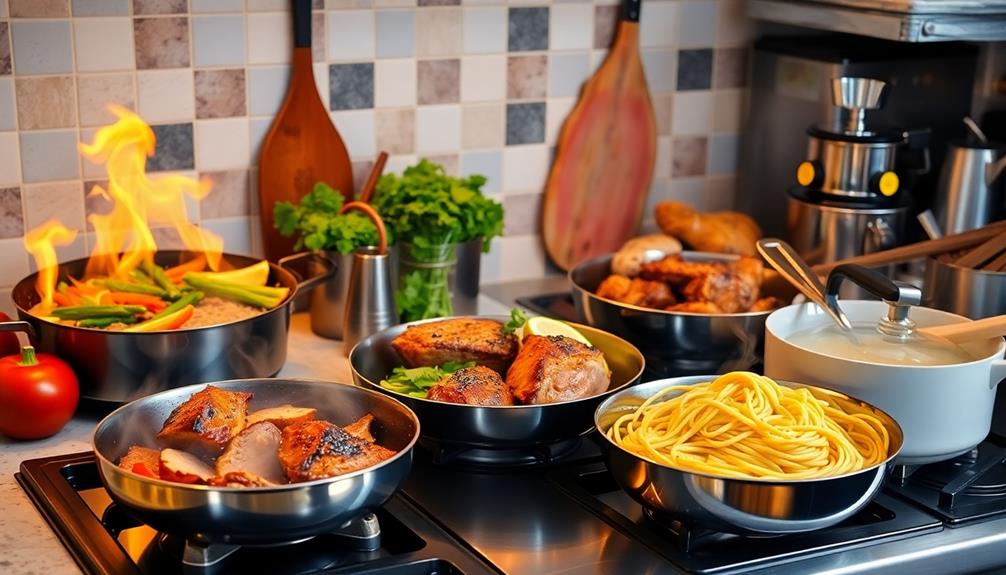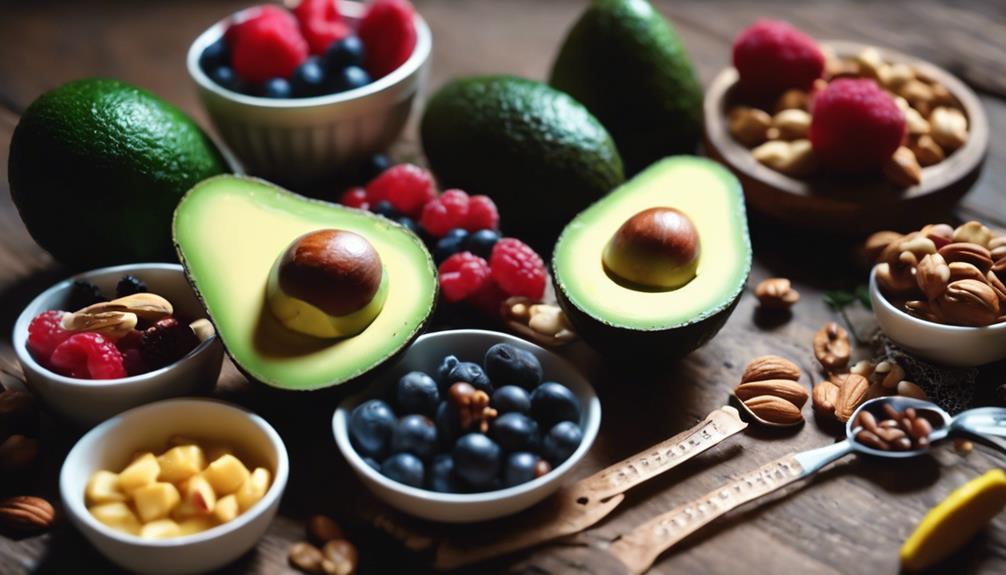Cooking methods play a significant role in shaping flavor compounds in your food. Techniques like steaming and microwaving effectively preserve volatile compounds, enhancing taste and aroma. Frying, on the other hand, boosts umami flavors through the Maillard reaction but often reduces complexity and nutritional benefits. Boiling can dilute flavors, leading to milder dishes. Each method impacts not just taste but also the nutrient content of your meals. By understanding how these methods interact, you can maximize both flavor and health benefits in your cooking. You might find some surprising details about your favorite techniques that could change your kitchen game.
Key Takeaways
- Cooking methods like steaming and microwaving preserve more volatile flavor compounds than boiling or frying, resulting in richer taste profiles.
- The Maillard reaction during frying and grilling enhances umami flavors and creates complex aromas, improving overall flavor appeal.
- Boiling often dilutes flavors, leading to milder taste profiles and a loss of critical flavor compounds compared to other methods.
- Different cooking techniques impact nutritional integrity, with steaming and microwaving retaining more nutrients than boiling and frying.
- Consumer preferences are influenced by cooking methods, as techniques like grilling and frying enhance sensory attributes like texture and aroma.
Overview of Cooking Methods
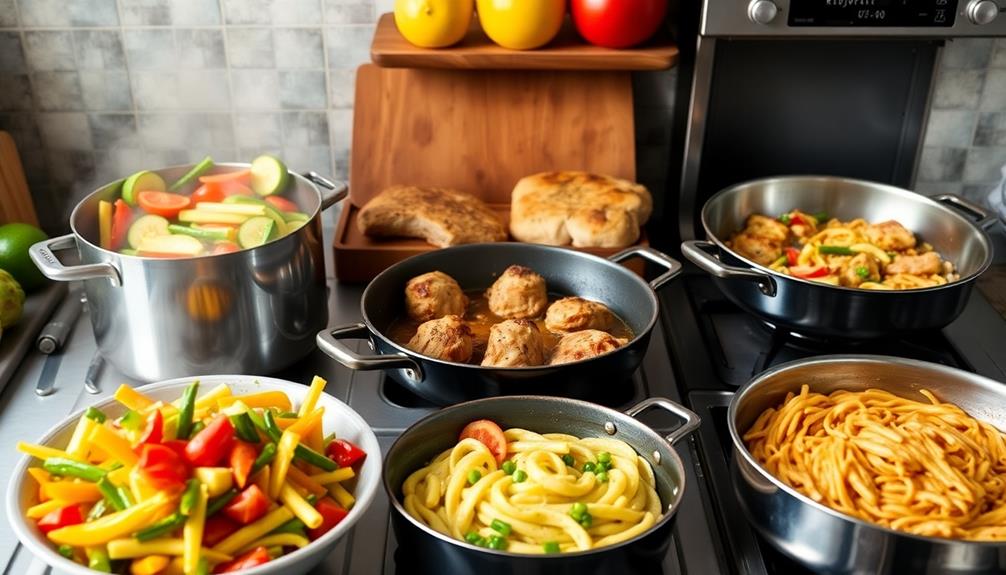
Cooking methods play an essential role in shaping the flavor and overall experience of your meals. Each technique—steaming, frying, boiling, and grilling—affects the sensory characteristics of food differently.
For instance, steaming preserves more volatile flavor compounds than boiling or frying, with steamed dishes yielding 61 compounds compared to just 49 in fried options. This retention enhances the freshness and vibrancy of flavors in your meals, similar to how Red-Braised Pork Belly highlights rich, caramelized flavors through slow braising.
On the other hand, boiling often dilutes flavors, resulting in milder taste profiles. Frying, however, works wonders by enhancing umami and introducing complex flavors through the Maillard reaction, offering a more intense flavor experience.
Grilling adds another layer, imparting smoky notes and charred flavors that many find appealing.
The choice of cooking method doesn't just affect taste; it also considerably impacts texture, aroma, and visual appeal. For example, grilled foods might have a crispy exterior paired with a juicy interior, while steamed dishes maintain a tender texture.
Understanding these differences in cooking methods allows you to make informed decisions, ultimately elevating your meals and satisfying your palate.
Impact on Flavor Compounds

Each cooking method leaves a distinct mark on the flavor compounds present in food. Steaming and microwaving stand out for their ability to retain volatile flavor compounds, enhancing the overall flavor profile. For example, dishes like Mushroom Masala benefit from these methods, as the rich blend of spices can be preserved more effectively.
In fact, steamed and microwaved samples of Clitocybe squamulosa revealed more volatile compounds—63 and 61, respectively—compared to just 54 in their raw state. On the other hand, frying tends to diminish flavor complexity, with only 49 volatile compounds detected in fried samples.
While frying may reduce some compounds, it does enhance umami flavors through the Maillard reaction, creating a different flavor experience. This method alters the flavor profile considerably, making it more savory but less complex.
Principal component analysis (PCA) and relative odor activity values (ROAV) highlight these differences, revealing how cooking methods shape flavor development.
Simply put, the way you cook can drastically change what you taste. Each method brings its own unique characteristics, so understanding these impacts can help you make more informed choices in the kitchen, ultimately enhancing your dining experience.
Nutritional Changes in Food

Nutritional integrity often hinges on the cooking methods you choose. Different techniques can greatly alter the nutritional constituents in your food, including proteins, amino acids, and carbohydrates.
For example, steaming and microwaving are excellent for preserving the nutrients in Clitocybe squamulosa, while boiling and frying can result in higher nutrient losses. Traditional dishes like Muamba De Galinha showcase how specific ingredients, when cooked properly, can maintain their nutritional value while enhancing flavor.
When you bake yellow-fleshed sweetpotato (YFSP), you'll notice a remarkable increase in soluble sugar content, jumping from 9.12% to 36.65%. This not only enhances sweetness but also impacts flavor compounds.
On the other hand, boiling retains more carotenoids compared to baking and steaming, showcasing how specific cooking effects vary across methods.
Furthermore, the antioxidant activity of Clitocybe squamulosa peaks after microwave cooking, underscoring the connection between cooking methods and the health benefits of food.
Effects on Antioxidant Activity

Antioxidant activity in foods can vary considerably depending on how you prepare them. Your choice of cooking methods plays an essential role in determining the levels of antioxidant properties, especially when it comes to mushrooms like Clitocybe squamulosa.
For instance, traditional Brazilian dishes like Caldeirada often rely on stewing, which allows flavors to meld and may help retain some beneficial compounds. If you want to maximize health benefits, method selection is key. Research shows that microwaving yields the highest antioxidant activity, while steaming also preserves these valuable bioactive compounds effectively.
On the other hand, boiling and frying can notably reduce antioxidant levels, diminishing their health advantages. When you boil or fry foods, you often lose critical flavor compounds along with those antioxidants.
This highlights the importance of understanding how different cooking techniques impact both nutritional quality and flavor.
Sensory Attributes and Consumer Preference
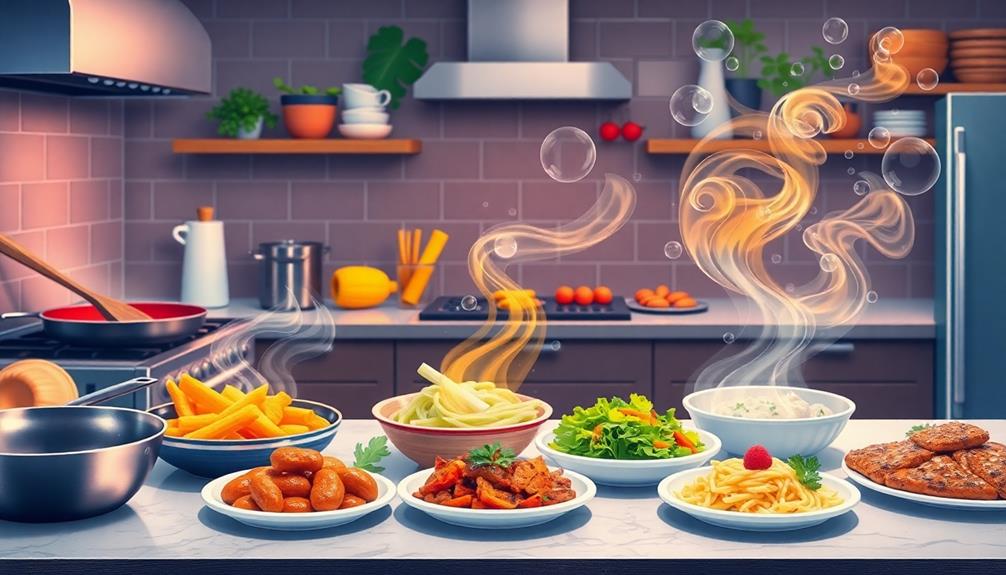
When you think about how cooking methods shape flavor perception, it's clear that your preferences can vary greatly.
For instance, frying enhances umami and creates a crispy texture, while steaming keeps ingredients tender and sweet.
Cooking methods can dramatically change the taste and texture of dishes like Loaded Baked Potato, which can be baked for a fluffy interior or fried for added crispiness.
These differences not only impact your enjoyment but also influence your choices at mealtime.
Flavor Perception Variability
Flavor perception varies dramatically depending on the cooking method used, affecting how you experience a dish's sensory attributes. Each technique influences not only the flavor but also the aroma intensity and texture, leading to varied consumer preferences.
For instance, boiling often results in milder flavors, while frying enhances umami and introduces complex notes through the Maillard reaction. In contrast, methods like Turkey Soup bring out rich flavors through slow cooking and the melding of ingredients.
Steaming preserves the natural sweetness and moisture, making it a favored method for retaining flavor profiles. Grilling, on the other hand, adds distinct smoky notes and charred flavors that many find appealing.
Here are some key factors that influence flavor perception:
- Cooking methods: Each method alters flavor compounds differently.
- Aroma intensity: Stronger aromas often enhance perceived flavor.
- Texture: Tenderness and juiciness can elevate overall acceptability.
- Familiarity: Consumers tend to prefer methods they're accustomed to.
- Visual appeal: The appearance of a dish can influence taste expectations.
Understanding these sensory attributes can help you appreciate how cooking techniques shape your culinary experiences and preferences.
Cooking Method Influence
The interplay between cooking methods and sensory attributes shapes your dining experience in profound ways. Different cooking methods greatly influence flavor compounds, impacting aroma, taste, and texture.
For instance, steaming preserves the natural sweetness of ingredients, while frying enhances umami and adds a crispy texture that many people crave. Southern dishes like squash casserole, when baked, develop a golden and bubbly surface that appeals to both the eye and palate.
You might notice that boiling often results in milder flavors, diluting the overall taste of the food. In contrast, grilling imparts smoky notes and charred flavors that appeal to a wide range of consumers.
The Maillard reaction during frying and grilling creates complex flavors and browning, contributing to an enticing aroma that boosts consumer acceptance.
Texture and juiciness are critical to your satisfaction; boiling yields softer food, while grilling produces firmer textures that many prefer. Additionally, visual appeal—including color and presentation—plays a major role in consumer preference.
Grilled items typically exhibit more vibrant hues compared to those prepared through other methods, making them more enticing on the plate.
Ultimately, the choice of cooking methods not only affects sensory characteristics but also influences your overall enjoyment of the meal.
Cultural Significance of Cooking Techniques
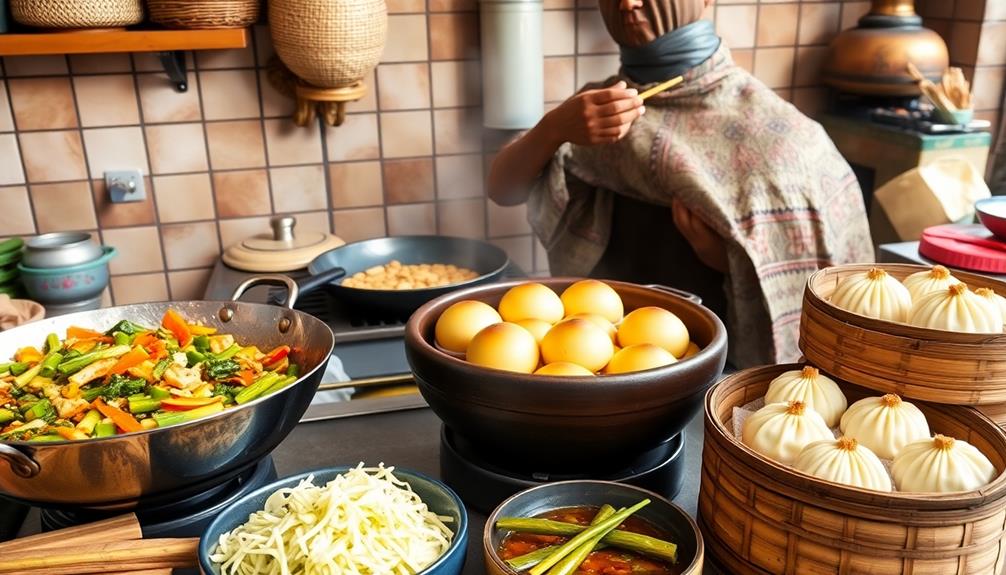
Cooking techniques aren't just about preparing food; they reflect the rich traditions and health beliefs of a culture.
For instance, the method of grilling meats, as seen in Korean BBQ, highlights not only flavor enhancement but also the communal aspect of dining that's integral to Korean culture.
When you explore these methods, you'll see how they shape flavor profiles and cater to modern health trends.
Understanding this connection can deepen your appreciation for the culinary practices that have stood the test of time.
Traditional Practices Influence Flavor
Rooted in cultural heritage, traditional cooking methods play an essential role in shaping the flavors we experience in various cuisines. Techniques like steaming and grilling are pivotal in preserving flavor compounds, enhancing aroma, and reflecting the cultural significance of the dishes.
For instance, steaming retains more volatile compounds compared to boiling and frying, while grilling leverages the Maillard reaction to develop complex flavors. In Ethiopian cuisine, for example, the preparation of dishes such as Yekolo (Roasted Barley) showcases the importance of roasting to enhance nutty flavors and nutritional value.
Consider the following aspects of traditional practices and their influence on flavor:
- Moisture retention: Steaming enhances sweetness, keeping ingredients tender.
- Flavor development: The Maillard reaction in grilling creates rich, savory notes.
- Culinary heritage: Specific techniques highlight local delicacies, like Clitocybe squamulosa in Shanxi Province, China.
- Aroma enhancement: Certain cooking methods are celebrated for their ability to intensify aromas.
- Consumer acceptance: Traditional practices impact regional food trends and market demand.
Health Trends and Preferences
With an increasing awareness of health and wellness, many people are turning to cooking methods that prioritize both flavor and nutritional integrity. You might notice that techniques like steaming and microwaving retain more volatile compounds, enhancing the sensory characteristics of your meals. This is similar to how dishes like Nettle and Potato Soup leverage fresh ingredients to maximize flavor.
These methods not only boost the taste but also preserve the nutritional properties of ingredients, aligning with current health trends. These methods not only boost the taste but also preserve the nutritional properties of ingredients, aligning with current health trends. By emphasizing natural flavors and mindful preparation, they cater to the growing interest in wholesome eating. Additionally, the blending of flavors can evoke foods connected to emotional responses, creating meals that resonate on a deeper, more personal level. This combination of nutrition and nostalgia solidifies their appeal in modern culinary practices.
The rising popularity of edible fungi, such as Clitocybe squamulosa from Shanxi Province, highlights how traditional culinary practices influence modern consumer preferences. These wild mushrooms are valued for their medicinal benefits, but it's essential to use proper cooking techniques to guarantee safety and maximize their flavor compounds.
As concerns about raw mushroom consumption grow, cooking becomes vital in enhancing both taste and health benefits.
Ultimately, a shift towards healthier cooking methods means you can enjoy meals that are both delicious and nutritious. By choosing techniques that maintain the integrity of your ingredients, you cater to your health needs while respecting culinary traditions.
Embracing these changes can lead to a more satisfying and health-conscious dining experience.
Practical Cooking Recommendations
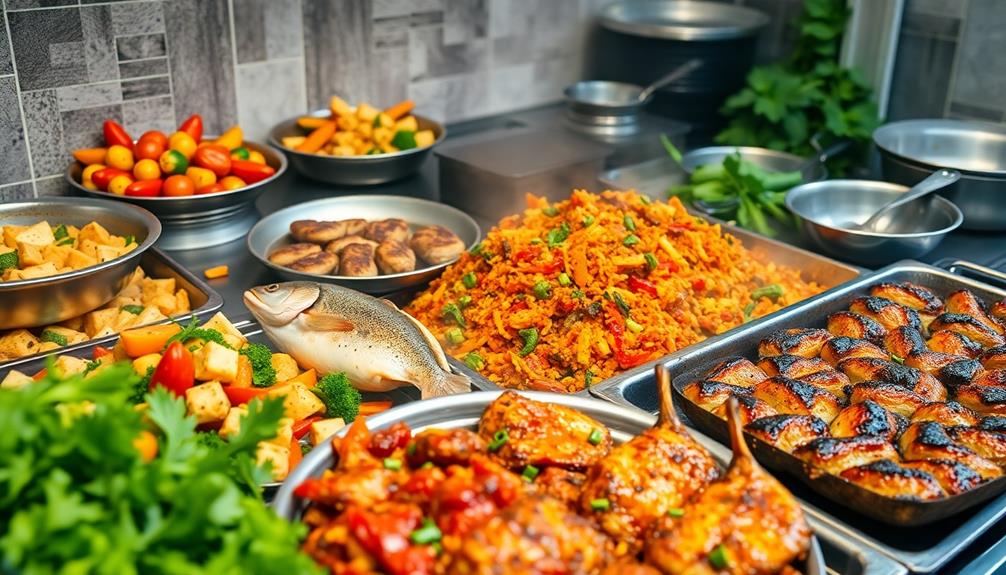
Many home cooks often overlook the impact of cooking methods on flavor and nutrition. To enhance both the taste and nutrient retention of your meals, consider the following practical recommendations:
- Steaming and microwaving are your best bets for preserving volatile compounds, particularly in mushrooms like Clitocybe squamulosa. They keep more flavor intact than boiling or frying.
- Boiling can dilute flavors, making your dish milder; avoid it when you want to retain bold tastes.
- If you crave crispy textures, frying is effective, utilizing the Maillard reaction for flavor enhancement, but remember it can lead to nutrient loss.
- For sweet potatoes, baking considerably boosts sweetness, increasing soluble sugar content from 9.12% to 36.65%.
- Grilling adds a smoky flavor that many love, but be aware it might reduce some vitamins; balance your methods for ideal flavor and nutrition.
Frequently Asked Questions
Does Cooking Method Affect Taste?
Yes, cooking method affects taste. When you choose steaming or microwaving, you keep more natural flavors. Boiling can dull them down, while frying intensifies umami, creating a richer, more complex flavor experience.
How Are Flavors Affected by Cooking?
When you cook, flavors transform. Different techniques bring out unique tastes and aromas, enhancing or diminishing the food's natural profile. Your choice of method affects overall enjoyment, as textures and scents play essential roles.
How Does the Cooking Method Affect the Texture and Flavor of the Meat?
The cooking method you choose impacts meat's texture and flavor considerably. Frying makes it crispy and rich, while steaming keeps it tender and sweet. Grilling adds smokiness, and boiling results in a milder profile.
How Does Different Cooking Methods Affect Food?
Imagine grilling a steak versus boiling it; you'll notice how grilling enhances its flavor and texture. Different cooking methods really shape food's taste, aroma, and nutritional benefits, making your meals more enjoyable and diverse.
Conclusion
To sum up, understanding how cooking methods affect flavor compounds can truly elevate your culinary skills. Did you know that sautéing can enhance the flavor of vegetables by up to 60% compared to boiling? This statistic highlights the importance of choosing the right technique. By experimenting with various methods, you can not only boost flavor but also preserve nutrients and antioxidants, making your meals tastier and healthier. So, get creative in the kitchen and enjoy the delicious results!

